
Advertising & Brands
-

Denial- Daniel Bombardier High Fashion I Louis Vuitton Blotter Print by Denial- Daniel Bombardier
High Fashion I Louis Vuitton Archival Blotter Paper Print by Denial- Daniel Bombardier Limited Edition Fine Art Archival Pigment Print Art on Perforated Blotter Paper. 2024 Signed & Numbered Limited Edition of 35 Archival Pigment Print on Perforated Blotter Paper Size: 7.5 x 7.5 Inches Release: April 19, 2024, Limited blotter editions are hand-perforated by Zane Kesey. Luxury Satirized in Street Pop Art & Graffiti Artwork High Fashion I Louis Vuitton by Denial, the alias of Canadian artist Daniel Bombardier, is a limited edition archival pigment print presented on perforated blotter paper. Released in April 2024 in an edition of 35, this work merges the aesthetics of luxury branding with a provocative medium traditionally associated with underground psychedelic culture. The iconic Louis Vuitton monogram and checkerboard pattern are front and center, layered in a meticulous design that plays with status, obsession, and commodification. Each edition is hand-perforated by Zane Kesey, creating a textural and conceptual connection between art, counterculture, and consumption. Daniel Bombardier’s Weaponized Iconography Daniel Bombardier has long explored the themes of consumerism and propaganda through his Street Pop Art & Graffiti Artwork. Under the name Denial, his pieces critique mass media, brand worship, and political manipulation. High Fashion I Louis Vuitton continues this practice by spotlighting a fashion house that represents wealth and global prestige. Bombardier’s use of a blotter sheet format, with its history in psychedelic counterculture and illicit print art, directly confronts the polished commercialism of high fashion. The tension between drug ephemera and elite design language becomes a visual statement about escapism, identity, and class divisions. Blotter Paper as Cultural Canvas The use of blotter paper is not just stylistic—it is symbolic. In the underground art world, perforated blotters serve as miniature canvases for satire and resistance. When applied to corporate logos or social icons, they become critiques of power and conformity. This edition's precision printing and clean finish contrast sharply with its renegade medium. Bombardier subverts the traditional format by maintaining luxury’s polished aesthetic while embedding it in a context known for anti-establishment expression. Each square of the print, though undosed, carries the historical weight of psychedelia and the DIY ethos of protest art. Reclaiming Commercial Imagery through Street Pop Commentary High Fashion I Louis Vuitton is a synthesis of controlled craftsmanship and critical commentary. The fusion of luxury branding with the modular form of blotter tabs invites questions about replication, status, and the ritual of purchasing identity. This is not simply appropriation; it is transformation. In the hands of Denial, Louis Vuitton’s visual empire becomes a satirical map, charting the boundaries between aspiration and illusion. Within the context of Street Pop Art & Graffiti Artwork, this piece asserts that nothing is above reinterpretation—not even fashion’s most sacred icons.
$500.00
-

Denial- Daniel Bombardier High Fashion Gucci Blotter Print by Denial- Daniel Bombardier
High Fashion Gucci Blotter Print by Denial- Daniel Bombardier Limited Edition Fine Art Archival Pigment Print Art on Perforated Blotter Paper. 2024 Signed & Numbered Limited Edition of 35 Archival Pigment Print on Perforated Blotter Paper Size: 7.5 x 7.5 Inches Release: April 19, 2024, Limited blotter editions are hand-perforated by Zane Kesey. High Fashion Gucci Blotter Print by Denial High Fashion Gucci by Denial, also known as Daniel Bombardier, boldly merges the visual codes of luxury branding with the gritty defiance of Street Pop Art & Graffiti Artwork. This limited edition print, released in 2024 as part of a 35-print run, measures 7.5 x 7.5 inches and is crafted using archival pigment inks on perforated blotter paper. With each piece hand-perforated by Zane Kesey, the work is both a nod to countercultural history and a sharp cultural critique. Denial’s use of blotter paper as a canvas underscores a larger message about escapism, consumption, and image manipulation in modern society. Luxury Rewired Through a Subversive Lens Centered around the iconic Gucci logo and set against a repeating branded pattern, the artwork includes a coiled red, black, and white serpent slithering across the surface. The visual blend of opulence and danger makes a striking impression. This symbolic snake—long associated with temptation, rebellion, and transformation—amplifies the tension between consumer desire and critical awareness. Denial does not distort the branding. Instead, he amplifies it, forcing the viewer to engage with the familiarity of the logo in a completely different context. The very use of blotter paper, historically linked to psychedelics, adds layers of metaphor about perception, transformation, and cultural illusion. Gucci and the Aesthetic of Power Gucci’s visual identity has become shorthand for status and aspiration, and this is exactly what Denial calls into question. In a world where logos often carry more cultural weight than the products themselves, the artist draws attention to the machinery of branding and its influence over identity and expression. Through the lens of Street Pop Art & Graffiti Artwork, this piece makes Gucci’s signature motifs accessible but also provocative. It turns fashion into a format for critique rather than celebration, showing how luxury aesthetics can be hijacked and repurposed as contemporary iconography. Daniel Bombardier’s Ongoing Commentary Denial continues to explore the relationships between media, branding, and cultural behavior. Known for fusing bold color palettes with subversive imagery, his High Fashion Gucci print delivers both visual satisfaction and layered meaning. By working on perforated blotter paper, he reinforces a tactile history of underground movements and counter-narratives. This artwork fits within a larger pattern of Denial’s efforts to blur the line between commercial art and social commentary. It is not just a stylish nod to high fashion. It is a streetwise deconstruction of consumerist illusion. Each dot, logo, and symbol demands a second look—not for what it sells, but for what it questions.
$500.00
-
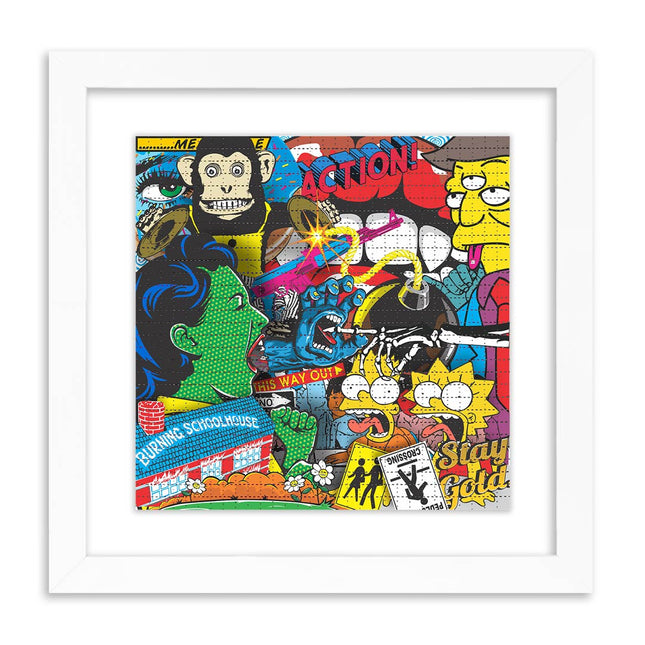
Denial- Daniel Bombardier LSDelinquent Blotter Paper Archival Print by Denial- Daniel Bombardier
LSDelinquent Blotter Paper Limited Edition Archival Pigment Print Art on Perforated Blotter Paper by Denial pop culture LSD artwork. 2019 Signed Limited Edition of 50 Artwork Size 7.5x7.5 In 2000 he adopted the moniker ‘DENIAL’ as a means of poking fun at advertising, politics, and media messages that contemporary society is often ‘in denial about. Since then he has maintained an ongoing global street-campaign of over 500, 000 stickers, placards, and murals, using the alpha-numeric characters ‘D3N!@L’. Intended as a conceptual means of marketing absurdism, DENIAL also challenges traditional notions of graffiti and public art through his bold and often satirical visual subversions. Denial’s art is strongly political and social since the artist takes specific positions against issues, such as capitalism, consumer culture, and advertisements. More importantly, the artist is aware of his choices and motivations: “I like to think of myself as activist pop art. How I relate with cartoons and graphics is a lot easier than I do with photo-realistic stuff" Another aspect of Denial's work is humor. His work is satirical, which, by definition, means that it uses humor as a confronting mechanism.
$385.00
-
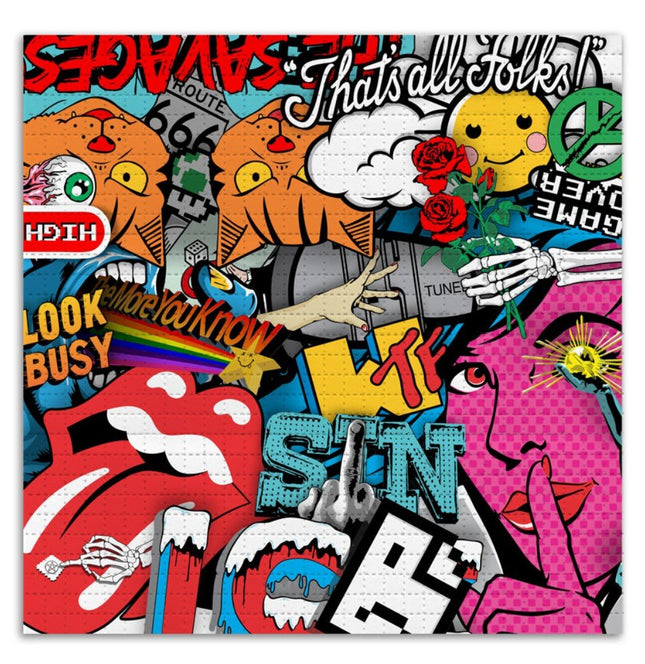
Denial- Daniel Bombardier I See What You Did There Blotter Paper Archival Print by Denial- Daniel Bombardier
I See What You Did There Blotter Paper Limited Edition Archival Pigment Print Art on Perforated Blotter Paper by Denial pop culture LSD artwork. 2021 Signed Limited Edition of 50 Artwork Size 7.5x7.5 Archival Pigment Print on Perforated Blotter Paper Size: 7.5 x 7.5 Inches Release: April 19, 2021. Limited blotter editions are hand-perforated by Zane Kesey & may vary slightly from the example shown. Denial’s art is strongly political and social since the artist takes specific positions against issues, such as capitalism, consumer culture, and advertisements. More importantly, the artist is aware of his choices and motivations: “I like to think of myself as activist pop art. How I relate with cartoons and graphics is a lot easier than I do with photo-realistic stuff" Another aspect of Denial's work is humor. His work is satirical, which, by definition, means that it uses humor as a confronting mechanism.
$385.00
-

Ben Frost Know Your Product Blotter Paper Archival Print by Ben Frost
Know Your Product Blotter Paper Limited Edition Archival Pigment Print Art on Perforated Blotter Paper by Ben Frost pop culture LSD artwork. 2020 Signed & Numbered Limited Edition of 100 Blotter Paper Print 7.5x7.5 Australian contemporary artist Ben Frost is best known for his bold, irreverent Pop Art. His instantly recognizable take on pop culture twists up everyday iconography from the world’s biggest brands. Subverting meaning and messages from the mainstream media, Frost’s scything commentary on advertising, entertainment, and politics is both confronting and controversial. The essence of Frost’s commentary is established on the basis of subverting the meaning and the messages, promoted by the mainstream media. In other words and, as he has stated in the past: “The less you fill your mind with the trappings of advertising and bad television, the more space you have in your brain for things of value”. At the same time, his take on modern pop culture is equally compelling. Mainstream media, advertisements, and politics can be identified as some of his main fields of interest, which he utilizes and mixes up in a controversial formation. The word controversial is not used incidentally. What Ben Frost’s art is doing is, essentially, the appropriation and weaponization of imagery against the same system that gave birth to it.
$385.00
-

Denial- Daniel Bombardier High Fashion II Hermès Blotter Print by Denial- Daniel Bombardier
High Fashion II Hermès Blotter Print by Denial- Daniel Bombardier Limited Edition Fine Art Archival Pigment Print Art on Perforated Blotter Paper. 2024 Signed & Numbered Limited Edition of 35 Archival Pigment Print on Perforated Blotter Paper Size: 7.5 x 7.5 Inches Release: April 19, 2024, Limited blotter editions are hand-perforated by Zane Kesey. High Fashion II Hermès Blotter Print by Denial High Fashion II Hermès by Denial, also known as Daniel Bombardier, captures a sharp commentary on luxury consumerism through the lens of Street Pop Art & Graffiti Artwork. Released in 2024 as a limited edition of 35 signed and numbered archival pigment prints, this 7.5 x 7.5 inch piece is printed on perforated blotter paper and hand-perforated by Zane Kesey. The work uses the instantly recognizable Hermès Paris branding and vivid orange palette to highlight the intersection of wealth symbolism and artistic subversion. As with many of Denial’s works, the use of luxury fashion iconography is both a nod to aspirational culture and a critique of its grip on identity and self-worth. Fashion as Commodity and Canvas In this print, Denial transforms the Hermès packaging into an object of reflection. The orange field, carriage motif, and Parisian serif typography remain visually intact, yet their presence on blotter paper invites reinterpretation. In the hands of Denial, this branded imagery becomes more than decorative. It takes on a satirical tone, challenging viewers to consider how brands shape desire and value. By placing this on a medium traditionally linked to psychedelia and altered consciousness, the artist brings a new layer of irony—how deep are we in the trance of consumerism when luxury logos elicit emotional responses? Street Pop Art & Graffiti Artwork as a Response to Luxury Culture Daniel Bombardier is known for blending sleek graphic sensibilities with raw social critique. His work often engages with consumerism, capitalism, and surveillance culture, and the High Fashion II Hermès print continues this thread. The piece balances reverence for the aesthetic of high-end branding with an interrogation of its psychological influence. As with the best examples of Street Pop Art & Graffiti Artwork, this print disrupts traditional spaces by repurposing symbols of status into agents of visual dissent. It belongs to a growing lineage of works that reframe logos and designer marks as objects of conversation rather than worship. The Luxury Logo as Cultural Code High Fashion II Hermès does not dilute its message. It elevates it through contrast. The clash of street aesthetics and high fashion visuals builds a dialogue about power, visibility, and access. Hermès, a brand known for restraint and craftsmanship, is reimagined in a format associated with the underground and countercultural expression. This transformation reframes luxury as something no longer untouchable, but critically examined. Denial’s work acts as a graphic mirror, held up to a society shaped by what it consumes and what it chooses to idolize. Through this limited blotter edition, Denial fuses critique and craft into a square of paper that speaks volumes.
$500.00
-

Denial- Daniel Bombardier High Fashion Goyard Blotter Print by Denial- Daniel Bombardier
High Fashion Goyard Blotter Print by Denial- Daniel Bombardier Limited Edition Fine Art Archival Pigment Print Art on Perforated Blotter Paper. 2024 Signed & Numbered Limited Edition of 35 Archival Pigment Print on Perforated Blotter Paper Size: 7.5 x 7.5 Inches Release: April 19, 2024, Limited blotter editions are hand-perforated by Zane Kesey. High Fashion Goyard Blotter Print: A Study in Pattern, Prestige, and Pop Subversion The High Fashion Goyard blotter print by Canadian Street Pop Art & Graffiti Artwork artist Daniel Bombardier, professionally known as Denial, turns the exclusivity of the Goyard brand into a compact and compelling artwork. Released April 19, 2024, as part of a fine art edition limited to just 35 pieces, this archival pigment print on perforated blotter paper is both precise in execution and rebellious in concept. With hand-perforation by Zane Kesey, the work carries an underground aesthetic despite its clean luxury reference. The piece measures 7.5 x 7.5 inches and continues Denial’s acclaimed critique of consumer culture, pushing iconic fashion imagery into new zones of commentary and collection. From Luxury Trunks to Counterculture Paper: The Recontextualization of Goyard Founded in Paris in 1853, Goyard became a symbol of tailored refinement with its hand-painted chevron monogram pattern and elite clientele. Denial captures that storied branding and distills it into a new artistic form—a perforated sheet traditionally used for psychedelic blotter art. This transformation places the logo and signature motif into a setting charged with countercultural energy. The repeating Goyard pattern, once associated with aristocracy and heritage, is reimagined as a textured background for satire and critique. The shift from luggage canvas to blotter format creates a visual and conceptual rupture that aligns with the confrontational and reflective themes of Street Pop Art & Graffiti Artwork. Denial’s Commentary on Obsession, Branding, and Exclusivity Daniel Bombardier’s work often dissects themes of consumption, capitalism, and identity through the appropriation of logos and advertising imagery. With this Goyard piece, he expands that language by referencing how logos function like currency and power in culture. The repetition of the Goyard insignia mimics the hypnotic qualities of both mass marketing and altered states, while the fine detailing, contrast, and symmetry give it an aesthetic punch. Denial continues to use high fashion not as admiration but as a lens through which to view and question aspiration, desire, and value. This piece places Goyard—typically seen on the arms of global elite—into a context where ideas, not wealth, drive attention. A Limited Blotter Print Made for Today’s Cultural Shifts As part of a larger series interpreting luxury fashion houses through a rebellious fine art practice, the Goyard blotter print finds its place between gallery wall and cultural archive. The hand-signed and numbered edition affirms the physical object as a collector’s item, while the blotter format alludes to deeper layers of metaphor and transformation. Zane Kesey’s participation in perforating the sheets links it to historical acid blotter designs, amplifying the surreal juxtaposition. Denial’s Goyard print is not merely a remix—it’s a precise cultural critique in the language of Street Pop Art & Graffiti Artwork, celebrating design while questioning the systems that idolize it.
$500.00
-
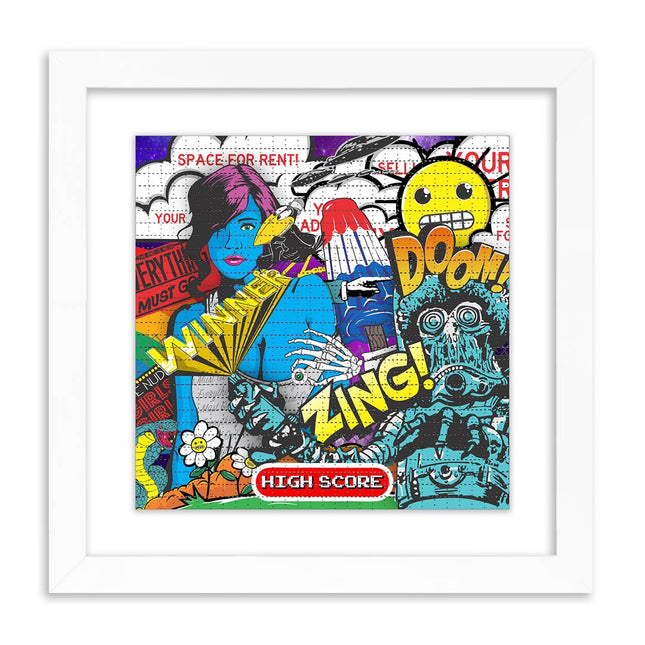
Denial- Daniel Bombardier High Score Blotter Paper Archival Print by Denial- Daniel Bombardier
High Score Blotter Paper Limited Edition Archival Pigment Print Art on Perforated Blotter Paper by Denial pop culture LSD artwork. 2020 Signed Limited Edition of 50 Artwork Size 7.5x7.5 In 2000 he adopted the moniker ‘DENIAL’ as a means of poking fun at advertising, politics, and media messages that contemporary society is often ‘in denial about. Since then he has maintained an ongoing global street-campaign of over 500, 000 stickers, placards, and murals, using the alpha-numeric characters ‘D3N!@L’. Intended as a conceptual means of marketing absurdism, DENIAL also challenges traditional notions of graffiti and public art through his bold and often satirical visual subversions. In the world of Denial, memory is important, because it is the basis of his work, as it nostalgically encourages the audience to engage with it. As a result, his art is as familiar, as it is disturbing because it reveals the most unsettling parts of society, the ones we are in a “denial” of. No matter its controversial history, graffiti is less and less viewed as a form of vandalism.
$385.00
-
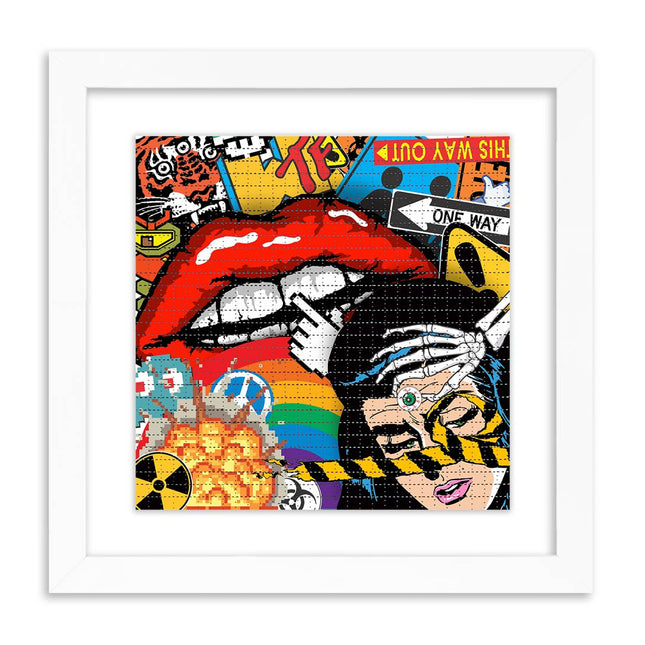
Denial- Daniel Bombardier LSDetroit Blotter Paper Archival Print by Denial- Daniel Bombardier
LSDetroit Blotter Paper Limited Edition Archival Pigment Print Art on Perforated Blotter Paper by Denial pop culture LSD artwork. 2019 Signed Limited Edition of 50 Artwork Size 7.5x7.5 In 2000 he adopted the moniker ‘DENIAL’ as a means of poking fun at advertising, politics, and media messages that contemporary society is often ‘in denial about. Since then he has maintained an ongoing global street-campaign of over 500, 000 stickers, placards, and murals, using the alpha-numeric characters ‘D3N!@L’. Intended as a conceptual means of marketing absurdism, DENIAL also challenges traditional notions of graffiti and public art through his bold and often satirical visual subversions. Denial is a Canadian artist who experiments with aerosol and stencil art, while his main fields of interest are consumerism, politics and the human condition in today’s society. Since the culture of graffiti was gaining more and more popularity in the US and Europe, the taggers had to be increasingly original in order to stand out. The signatures became bigger, more stylized and more colorful.
$385.00
-
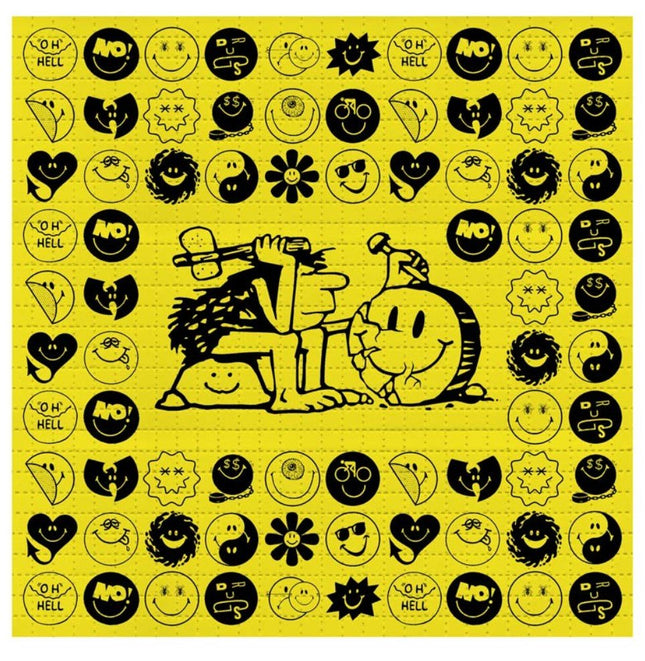
Rich Browd Happy Hits 2 Blotter Paper Archival Print by Rich Browd
Happy Hits 2 Blotter Paper Limited Edition Archival Pigment Print Art on Perforated Blotter Paper by Rich Browd pop culture LSD artwork. Archival Pigment Print on Perforated Blotter Paper Size: 7.5 x 7.5 Inches Release: April 19, 2021 Limited blotter editions are hand-perforated by Zane Kesey & may vary slightly from the example shown.
$352.00
-

Denial- Daniel Bombardier High Fashion Burberry Blotter Print by Denial- Daniel Bombardier
High Fashion Burberry Blotter Print by Denial- Daniel Bombardier Limited Edition Fine Art Archival Pigment Print Art on Perforated Blotter Paper. 2024 Signed & Numbered Limited Edition of 35 Archival Pigment Print on Perforated Blotter Paper Size: 7.5 x 7.5 Inches Release: April 19, 2024, Limited blotter editions are hand-perforated by Zane Kesey. Burrrrberrrrry as Reimagined in Street Pop Art & Graffiti Artwork Daniel Bombardier, professionally known as Denial, continues his cultural deconstruction of luxury symbolism with the 2024 release of the High Fashion Burberry blotter print. This limited edition artwork is executed on perforated blotter paper, a material long associated with counterculture and psychedelic art. Hand-perforated by Zane Kesey and measuring 7.5 by 7.5 inches, the print merges high fashion branding with street-level critique. Featuring a warped reinterpretation of the Burberry logo as Burrrrberrrrry, this piece questions the constructed prestige of fashion houses through the lens of Street Pop Art & Graffiti Artwork. The distinctive Burberry tartan and iconic equestrian knight emblem remain central, but their presentation is filtered through a playful, disruptive, and highly subversive artistic voice. Subverting Heritage Branding Through Satire and Street Culture The Burberry brand, established by Thomas Burberry in England in 1856, has cultivated an image synonymous with British sophistication and functional elegance. In Denial's version, this legacy is visually distorted. The stretched-out text exaggerates the branding to the point of absurdity, effectively dismantling its seriousness. The classic beige, red, and black plaid—a symbol of high fashion and sometimes rebellious subculture—dominates the lower half of the composition, emphasizing the duality of its place in culture as both exclusive and imitated. Denial’s use of humor and repetition transforms the logo into something excessive and ironic, echoing the ways luxury fashion often finds itself commodified and memed within internet and street-based creative spaces. Denial’s Commentary on Consumer Fetishism and Art Commodification Denial’s High Fashion series critiques not just the fashion industry but also the commodification of everything, including art itself. By printing these designs on blotter paper, a medium associated with the underground and mind-altering experience, Denial intentionally blurs the line between commercial branding and counterculture. This tension is at the heart of Street Pop Art & Graffiti Artwork—where luxury logos are often repurposed as statements on mass consumption, wealth, and identity. Denial does not simply parody Burberry but recontextualizes its meaning within an art form that thrives on social commentary and subversive aesthetics. The piece becomes an invitation to question what gives a brand its power, and who has the right to disrupt that image. Burberry in the Crosshairs of Visual Dissent By placing Burberry within the structure of limited-edition blotter art, Denial reframes the brand not as an untouchable institution but as a malleable object within the hands of the public. This act is in keeping with the ethos of graffiti and street art, which often refuse to respect boundaries imposed by property, power, or prestige. Artists like Denial leverage these visuals not for homage but to expose the artificial layers beneath luxury. The High Fashion Burberry blotter print serves both as a collectible artwork and a critique wrapped in aesthetic appeal, reminding viewers that in the world of Street Pop Art & Graffiti Artwork, no icon is too sacred to remix.
$500.00
-

Denial- Daniel Bombardier High Fashion Chanel Blotter Print by Denial- Daniel Bombardier
High Fashion Chanel Blotter Print by Denial- Daniel Bombardier Limited Edition Fine Art Archival Pigment Print Art on Perforated Blotter Paper. 2024 Signed & Numbered Limited Edition of 35 Archival Pigment Print on Perforated Blotter Paper Size: 7.5 x 7.5 Inches Release: April 19, 2024, Limited blotter editions are hand-perforated by Zane Kesey. Chanel Reimagined in Street Pop Art & Graffiti Artwork The unmistakable double C logo of Chanel has long stood as a symbol of luxury, status, and timeless fashion, yet in the world of Street Pop Art & Graffiti Artwork, it takes on a new identity. Chanel, founded by Gabrielle Chanel in France during the early twentieth century, revolutionized fashion through clean lines and modern elegance. In the context of urban art, its pristine image is often recontextualized as a critique, satire, or celebration of wealth culture and identity. Artists like Daniel Bombardier, also known as Denial, use this emblem to explore the commodification of status and the blending of luxury and rebellion. Luxury Disrupted: Daniel Bombardier’s Artistic Commentary In 2024, Daniel Bombardier released a limited edition blotter paper artwork titled High Fashion Chanel. With an edition of only thirty-five, this archival pigment print was applied on hand-perforated blotter paper by Zane Kesey, a figure associated with psychedelic culture. The medium alone offers a layered context, hinting at altered states and counterculture movements. The bold Chanel logo dominates a minimalist yet highly repetitive background, turning the monogram pattern into both a celebration and subversion of consumerist branding. What traditionally represents refinement and class is reframed as something mass-produced and industrial, raising questions about the values consumers assign to logos and heritage. Visual Language and the Power of the Symbol The use of blotter paper in this edition is more than a stylistic decision. Its association with underground psychedelia adds another layer to the interpretation, aligning the visual impact of the work with ideas of transformation, critique, and satire. Bombardier is known for blending commercial aesthetics with provocative messages, and this Chanel print is no exception. The composition presents a clean layout that invites viewers to engage with how deeply symbols have embedded themselves into culture. The repetition of the Chanel monogram mimics advertising saturation, while the clean lines reference the brand's original design ethos, creating tension between reverence and critique. Street Pop Art & Graffiti Artwork Meets Fashion Iconography High Fashion Chanel reflects how street-level art forms engage with fashion not only as design but as commentary. This blotter print stands as both an homage and interrogation of luxury’s influence on identity, class, and aspiration. Denial’s work joins a broader conversation where fashion logos are used as tools for expression, resistance, or humor in urban visual culture. Through precise design, unexpected mediums, and intentional appropriation, Chanel’s image is reworked into something both familiar and radically transformed—making it an ideal subject within the language of Street Pop Art & Graffiti Artwork.
$500.00
-
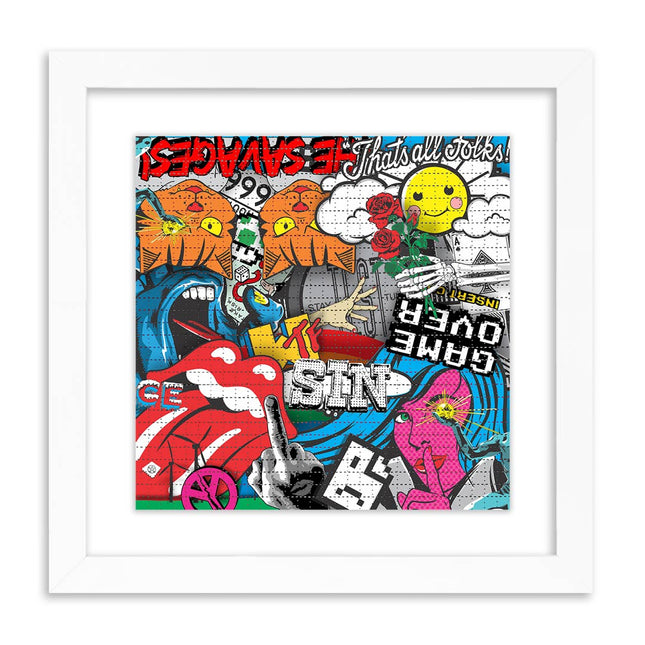
Denial- Daniel Bombardier Acid Test Results Blotter Paper Archival Print by Denial- Daniel Bombardier
Acid Test Results Blotter Paper Limited Edition Archival Pigment Print Art on Perforated Blotter Paper by Denial pop culture LSD artwork. In 2000 he adopted the moniker ‘DENIAL’ as a means of poking fun at advertising, politics, and media messages that contemporary society is often ‘in denial about. Since then he has maintained an ongoing global street-campaign of over 500, 000 stickers, placards, and murals, using the alpha-numeric characters ‘D3N!@L’. Intended as a conceptual means of marketing absurdism, DENIAL also challenges traditional notions of graffiti and public art through his bold and often satirical visual subversions. Denial has evolved as one the most prominent figures of contemporary pop artists, who nonetheless, continue to stay relevant and is interested in generating thought-provoking commentary. He has a long history of exploring the boundaries of appropriation, which he uses as a means of subverting the value of cultural products, imprinted in the collective memory of the Western civilization. His work, in other words, is inviting the viewer to re-imagine our dystopian society as a way of confronting it, with humor and irony as the biggest tools of the artist.
$385.00














